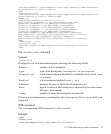Example
(gdb)
-break-insert main
^done,bkpt=number="1",type="breakpoint",disp="keep",enabled="y",
addr="0x000100d0",func="main",file="hello.c",line="5",times="0"(gdb)
-break-after 1 3
~
^done
(gdb)
-break-list
^done,BreakpointTable={nr_rows="1",nr_cols="6",
hdr=[{width="3",alignment="-1",col_name="number",colhdr="Num"},
{width="14",alignment="-1",col_name="type",colhdr="Type"},
{width="4",alignment="-1",col_name="disp",colhdr="Disp"},
{width="3",alignment="-1",col_name="enabled",colhdr="Enb"},
{width="10",alignment="-1",col_name="addr",colhdr="Address"},
{width="40",alignment="2",col_name="what",colhdr="What"}],
body=[bkpt={number="1",type="breakpoint",disp="keep",enabled="y",
addr="0x000100d0",func="main",file="hello.c",line="5",times="0",
ignore="3"}]}
(gdb)
The -break-condition command
Synopsis
-break-condition number expr
Breakpoint number will stop the program only if the condition in expr is true. The
condition becomes part of the '-break-list' output (see the description of the
'-break-list' command below).
GDB command
The corresponding GDB command is 'condition'.
Example
(gdb)
-break-condition 1 1
^done
(gdb)
-break-list
^done,BreakpointTable={nr_rows="1",nr_cols="6",
hdr=[{width="3",alignment="-1",col_name="number",colhdr="Num"},
{width="14",alignment="-1",col_name="type",colhdr="Type"},
{width="4",alignment="-1",col_name="disp",colhdr="Disp"},
{width="3",alignment="-1",col_name="enabled",colhdr="Enb"},
{width="10",alignment="-1",col_name="addr",colhdr="Address"},
{width="40",alignment="2",col_name="what",colhdr="What"}],
body=[bkpt={number="1",type="breakpoint",disp="keep",enabled="y",
21.5 GDB/MI breakpoint table commands 313


















